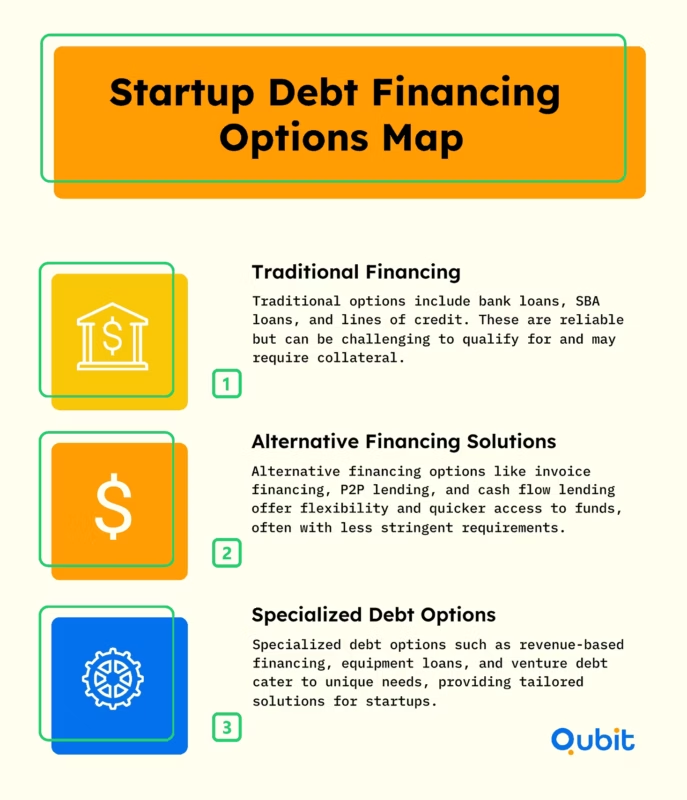Starting a business often requires significant capital, and debt financing for startups can be a practical solution to secure the funds needed without giving up equity. However, traditional banks have historically been hesitant to lend to startups, particularly after the 2008 financial crisis. According to Biz Journals, this reluctance has only grown in the post-crisis environment, leading many entrepreneurs to explore alternative financing options.
The demand for funding is immense, with 30.7 million small- and medium-sized enterprises (SMEs) in the U.S. as of 2019, collectively employing nearly 60 million people. Understanding the types of startup funding available is essential for entrepreneurs, especially when considering debt financing as a strategic option. This blog will guide you through various debt financing options, from traditional loans to innovative alternatives. Let’s jump right in!
Understanding Debt Financing Overview
Debt financing is a method of raising capital through borrowing, where funds are repaid over time with interest. This approach allows businesses to secure the financial resources they need without sacrificing ownership or control. Unlike equity financing, which involves selling shares of the company, debt financing ensures that founders and existing stakeholders retain full decision-making authority.
For startups, understanding what is debt financing is crucial, as it provides a pathway to growth while maintaining ownership. Historically, challenges in lending practices have shaped the way businesses approach borrowing, emphasizing the importance of selecting the right financing options.
Comparing Debt, Equity, and the Rise of Venture Debt
Startups face critical decisions when it comes to funding their growth, often navigating the trade-offs between taking on debt or raising equity. Equity vs debt financing is a key consideration in this process, with each option presenting distinct advantages and challenges.
Equity financing involves selling ownership stakes in the company. While it can bring in substantial capital and valuable investor expertise, it also dilutes the founder’s ownership and control. Debt financing, by contrast, allows startups to access capital through loans without giving up equity—but it comes with the obligation of repayment, often with interest.
In recent years, a hybrid solution has emerged and gained traction: venture debt. This specialized form of debt financing is designed specifically for startups, particularly those in later stages with consistent revenue. It provides a way to raise funds between equity rounds—helping founders extend their runway or accelerate growth without immediately turning to more equity financing.
The rise of venture debt is backed by compelling numbers. In 2024, U.S. venture debt deals soared to $53.3 billion, a 94% increase from the previous year. The average deal size also climbed significantly, hitting $46 million—a 125% jump compared to 2020. These figures reflect the increasing reliance on venture debt as a strategic tool in the broader equity vs debt financing landscape.
Ultimately, the choice between debt and equity is about balance: preserving ownership versus managing financial obligations. Understanding this dynamic is crucial for startups aiming to scale efficiently while maintaining strategic control.
How Debt Financing Works: Mechanics and Repayment Structures
Debt financing operates through a structured process involving the principal amount borrowed, interest rates, and repayment terms. At its core, the borrower agrees to repay the lender over a specified period, with interest serving as the cost of borrowing. The debt financing def lies in its ability to provide businesses with immediate capital without diluting ownership.
Interest rates, a critical component, are influenced by factors such as the borrower’s creditworthiness and broader macroeconomic conditions. For instance, insights from the Federal Reserve highlight how central bank policies and economic trends impact borrowing costs. A company with strong financial health and a high credit score typically secures lower interest rates, while startups or businesses with limited credit history may face higher costs.
Repayment structures vary widely. Some lenders offer flexible terms, while others require fixed monthly payments. For SaaS companies, financing amounts often correlate with their Monthly Recurring Revenue (MRR). Lenders may provide loans that are 3-5 times the startup’s MRR, enabling predictable repayment schedules tied to revenue generation.
Understanding these mechanics is essential for businesses aiming to optimize their funding strategies. By evaluating creditworthiness and staying informed about economic trends, companies can secure favorable terms and manage repayment effectively.
Exploring Types of Debt Financing Options for Startups
Finding the right funding solution is a critical step for startups aiming to scale their operations. Among the various methods, debt financing offers a range of options tailored to different needs. This section explores the types of debt financing for startups, from traditional bank loans to innovative alternatives like revenue-based financing and equipment loans.

Traditional Debt Financing Options
- Bank Loans
Bank loans remain a go-to choice for startups with strong credit histories and collateral. These loans typically offer lower interest rates but require extensive documentation and a proven financial track record. While they may not suit early-stage startups, they are ideal for businesses with stable cash flows. - SBA Loans
For startups seeking government-backed support, SBA Loans provide an excellent option. These loans come with favorable terms, such as lower interest rates and extended repayment periods, thanks to federal backing. Founders can also use the SBA Lenders tool to connect with reputable lenders that align with their needs. - Lines of Credit
A line of credit offers flexibility, allowing startups to borrow funds as needed up to a predetermined limit. This option is particularly useful for managing short-term expenses or bridging cash flow gaps.
Alternative Financing Models
- Cash Flow Lending
Startups without substantial collateral can explore cash flow lending. This model evaluates a business’s cash flow rather than its assets to determine loan eligibility. - Peer-to-Peer (P2P) Lending
Emerging platforms for Peer-to-Peer (P2P) lending offer startups a direct way to secure funding from individual investors. This method is often faster and less restrictive than traditional loans. - Invoice Financing
Invoice financing allows startups to unlock working capital tied up in unpaid invoices. Typically, this method advances 70–95% of the invoice value, providing immediate liquidity to cover operational costs.
Specialized Debt Financing Options
- Revenue-Based Financing
Revenue-based financing ties repayments to a percentage of monthly revenue, making it a flexible option for startups with fluctuating income. This model ensures that repayments align with the business’s performance, reducing financial strain during slower months. - Equipment Financing
Startups requiring significant capital for machinery or tools can consider equipment financing. Here, the purchased equipment itself serves as collateral, simplifying the qualification process.
For founders exploring more advanced financing strategies, convertible debt vs SAFE notes offers flexible options that balance investor appeal with founder control.
However, the fixed repayment terms associated with debt financing can strain cash flow, especially for startups in their early stages. Missing a repayment can lead to penalties or damage to creditworthiness, making it a high-stakes decision.
To illustrate, CoreWeave, an AI cloud infrastructure company, secured a $7.5 billion debt financing facility in May 2024. This substantial funding, led by Blackstone and Magnetar, was aimed at expanding their high-performance computing capabilities to meet the growing demand for AI infrastructure.
Similarly, Stripe, a leading fintech company, raised $600 million in a funding round in March 2021, achieving a $95 billion valuation. This capital was intended to support their European expansion and reinforce their enterprise leadership, demonstrating how strategic financing can fuel growth while maintaining control.
Striking the right balance between debt and equity is essential for sustainable growth. As highlighted in our article on balancing equity and debt financing, startups must carefully assess their financial strategies to avoid over-leveraging or losing control.
By understanding both the benefits and risks, startups can make informed decisions about whether debt financing aligns with their long-term goals.
Navigating the Debt Financing Application Process and Interest Rates
Securing debt financing means understanding the steps involved and preparing thoroughly to meet lender expectations. Start by organizing detailed financial statements, including balance sheets, income statements, and cash flow projections. These documents provide lenders with a clear picture of your business's financial health and repayment capacity.
Next, familiarize yourself with the criteria lenders use to evaluate applications. This often includes credit scores, debt-to-income ratios, and business performance metrics. Knowing these benchmarks helps you identify areas to strengthen before applying.
Interest rates play a crucial role in determining the affordability of a loan. To assess feasible ranges, use resources like Loan Rates, which provide benchmark data on average small business loan interest rates. Comparing these trends ensures you’re not overpaying for financing and helps you negotiate better terms.
Preparation and research are key to securing favorable debt financing. By aligning your financial profile with lender expectations and understanding market interest rates, you can position your business for success.
Conclusion
Understanding the diverse landscape of debt financing is essential for startups aiming to scale effectively. Throughout this blog, we’ve explored key strategies, from traditional loans to innovative funding options, emphasizing the importance of tailoring financial solutions to your business needs. Preparing comprehensive financial documentation and evaluating various funding avenues can significantly enhance your chances of securing the right support.
If you’re ready to take the next step in identifying investors who align with your growth vision, we’re here to help. At Qubit Capital, our Investor Discovery and Mapping service is designed to connect you with the right opportunities. Let’s get started on building a stronger financial foundation for your startup’s success.
Key Takeaway
-
Debt financing offers startups a non-dilutive funding option with potential tax benefits.
-
A range of options exist, from traditional bank loans to alternative and specialized financing models.
-
Venture debt has emerged as a critical tool for later-stage startups, fueling significant growth.
-
Understanding repayment structures and key terminology is essential for effective debt management.
-
Proper financial preparation is crucial for successfully securing debt financing.
Frequently asked Questions
What are the different types of debt financing?
Debt financing options include traditional loans, lines of credit, bonds, and alternative routes like revenue-based, invoice, and equipment financing.


 Back
Back



